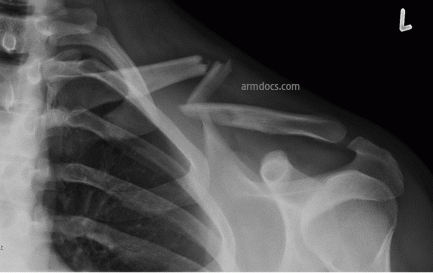How is a clavicle fracture diagnosed?
Fractures of the clavicle may be suspected from the mechanism of injury resulting in pain, deformity and bruising over the collarbone. The diagnosis is confirmed on X-rays of the shoulder. In some instances a CT scan may be arranged to study the fracture in greater detail and help plan the operation.
How is a clavicle fracture treated?
Non-operative treatment
The initial treatment will consist of supporting the arm in a sling, the use of oral pain medication and advice on protection of the arm. Whilst your arm is in a sling you will be advised to keep the fingers, wrist and elbow moving to prevent stiffness. As the pain in the shoulder settles, you will be encouraged to start gradually moving the shoulder. If the fracture is minimally displaced, then this treatment is continued until the fracture has healed.
Surgical treatment
In cases where the fracture is badly displaced or fragmented or if early return to function is desired, the fracture may be treated with an operation. The exact nature of the operation will depend on the location and pattern of the fracture.
Plate fixation: This is the preferred method of treatment in selected individuals with displaced fractures of the middle third of the clavicle. It consists of realigning the fragments of bone to restore its length and shape and then fixing with a plate and screws, which hold the position of the fragments until the fracture has healed. The fracture will usually go on to heal over a period of 3 to 6 months.
Suspensory fixation: Fractures of the outer end of the clavicle are often associated with disruption of the coracoclavicular ligaments and may be treated with a suspensory device such as a “tight-rope”. The device may be inserted arthroscopically (“key-hole” surgery) or through an open operation.
How long does it take to recover from a clavicle fracture?
Recovery will depend to some extent on the severity of the fracture and the type of treatment. Pain usually starts easing within a couple of weeks. You may start using the hand and elbow, as the arm gets comfortable. You will initially be moving the arm below shoulder for the first 4 weeks. Office duties may be resumed within 2-3 weeks. Strenuous task should be avoided until the fracture has healed over a period of 3-6 months.
